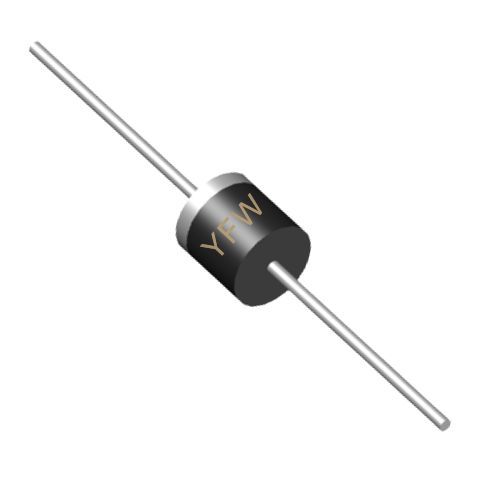A thyristor is a four-layer semiconductor device with a PNPN structure, consisting of alternating P-type and N-type materials. It features three terminals: an anode (A), a cathode (K), and a gate (G). The device operates as a bistable switch, transitioning between off (blocking) and on (conducting) states based on the applied voltages and gate triggering.
The PNPN structure creates three PN junctions (J1, J2, J3). Depending on the biasing conditions, thyristors exhibit three distinct modes:
Reverse Blocking Mode: When the anode is negative relative to the cathode, junctions J1 and J3 are reverse-biased, while J2 is forward-biased. No current flows, and the device remains in the off state.
Forward Blocking Mode: With a positive anode voltage and no gate signal, J1 and J3 are forward-biased, but J2 remains reverse-biased. The thyristor blocks current until the forward voltage exceeds the breakdown threshold or a gate trigger is applied.
Forward Conducting Mode: A positive gate current reduces the reverse bias on J2, triggering avalanche breakdown and enabling current flow from the anode to the cathode. Once 导通,the thyristor remains on even if the gate signal is removed, as long as the anode current exceeds the holding current (IH).
The thyristor’s behavior can be visualized using an equivalent circuit of two interconnected transistors: a PNP and an NPN transistor. When the gate is triggered, the PNP transistor’s collector current drives the NPN transistor into saturation, creating a positive feedback loop that locks the device into conduction. This mechanism explains the thyristor’s latching behavior, where it maintains conduction until the anode current drops below IH.
Thyristor performance is defined by several critical parameters, which directly impact their suitability for specific applications. YFW
Diode’s thyristors, such as the X0405 and MCR100-8, are engineered to meet rigorous standards, ensuring optimal efficiency and reliability.
Reverse Repetitive Peak Voltage (VRRM): The maximum repetitive reverse voltage the thyristor can withstand without breakdown. For YFW’s MCR100-8, VRRM reaches 800V, making it suitable for high-voltage applications.
Forward Blocking Voltage (VDRM): The maximum repetitive forward voltage the device can block in the off state. Exceeding VDRM without a gate trigger may cause unintended conduction.
Rated On-State Current (IT(RMS)): The maximum RMS current the thyristor can carry continuously under specified conditions. YFW’s X0405 supports 4A RMS, ideal for moderate-power systems.
Holding Current (IH): The minimum anode current required to maintain conduction. If the current drops below IH, the thyristor reverts to the off state. For the MCR100-8, IH is 5mA, ensuring stable operation in low-power circuits.
Surge Current (ITSM): The maximum non-repetitive current the device can handle during short-term overloads. YFW’s thyristors are designed to withstand surge currents up to 8A, protecting against transient spikes.
Gate Trigger Voltage (VGT) and Current (IGT): The minimum voltage and current required at the gate to initiate conduction. YFW’s MCR100-8 features a VGT of 800mV and IGT of 5mA, enabling precise control with low-power signals.
Latching Current (IL): The minimum anode current needed to sustain conduction immediately after triggering. IL is typically higher than IH and ensures reliable turn-on in inductive loads.
On-State Voltage Drop (VTM): The voltage across the thyristor when conducting, directly affecting power dissipation. YFW’s X0405 exhibits a VTM of 1.65V at rated current, minimizing energy loss.
Turn-Off Time (tq): The time required for the thyristor to regain blocking capability after the anode current ceases. This parameter is critical for high-frequency applications.
Junction Temperature (Tj): The maximum operating temperature of the semiconductor junctions. YFW’s thyristors are rated for Tj up to 125°C, ensuring stability in harsh environments.
Thyristors excel in applications requiring high-power control and switching:
Power Conversion: Used in rectifiers, inverters, and AC voltage regulators to manage energy flow in industrial systems.
Motor Control: Employed in variable-speed drives to adjust motor speed and torque efficiently.
Lighting Systems: Enable dimming in AC circuits by controlling the conduction angle, as seen in household and commercial lighting solutions.
Renewable Energy: Integral to solar inverters and wind turbine converters for grid synchronization and power conditioning.
YFW
Diode’s thyristors, with their robust design and precise parameters, are trusted in these applications globally, ensuring seamless performance and longevity.
Thyristors are indispensable in modern power electronics, offering efficient control of high currents and voltages. Understanding their working principle—from the PNPN structure to the gate-triggered conduction mechanism—and key parameters—such as voltage ratings, current thresholds, and thermal characteristics—is vital for selecting the right device. YFW
Diode’s commitment to innovation and quality ensures that our thyristors, like the X0405 and MCR100-8, deliver superior performance, reliability, and adaptability across diverse industries. By leveraging these components, engineers can design robust, cost-effective systems that meet the demands of today’s energy landscape.
For detailed specifications and technical support, visit
YFW Diode to explore our comprehensive range of thyristors and power semiconductor solutions
